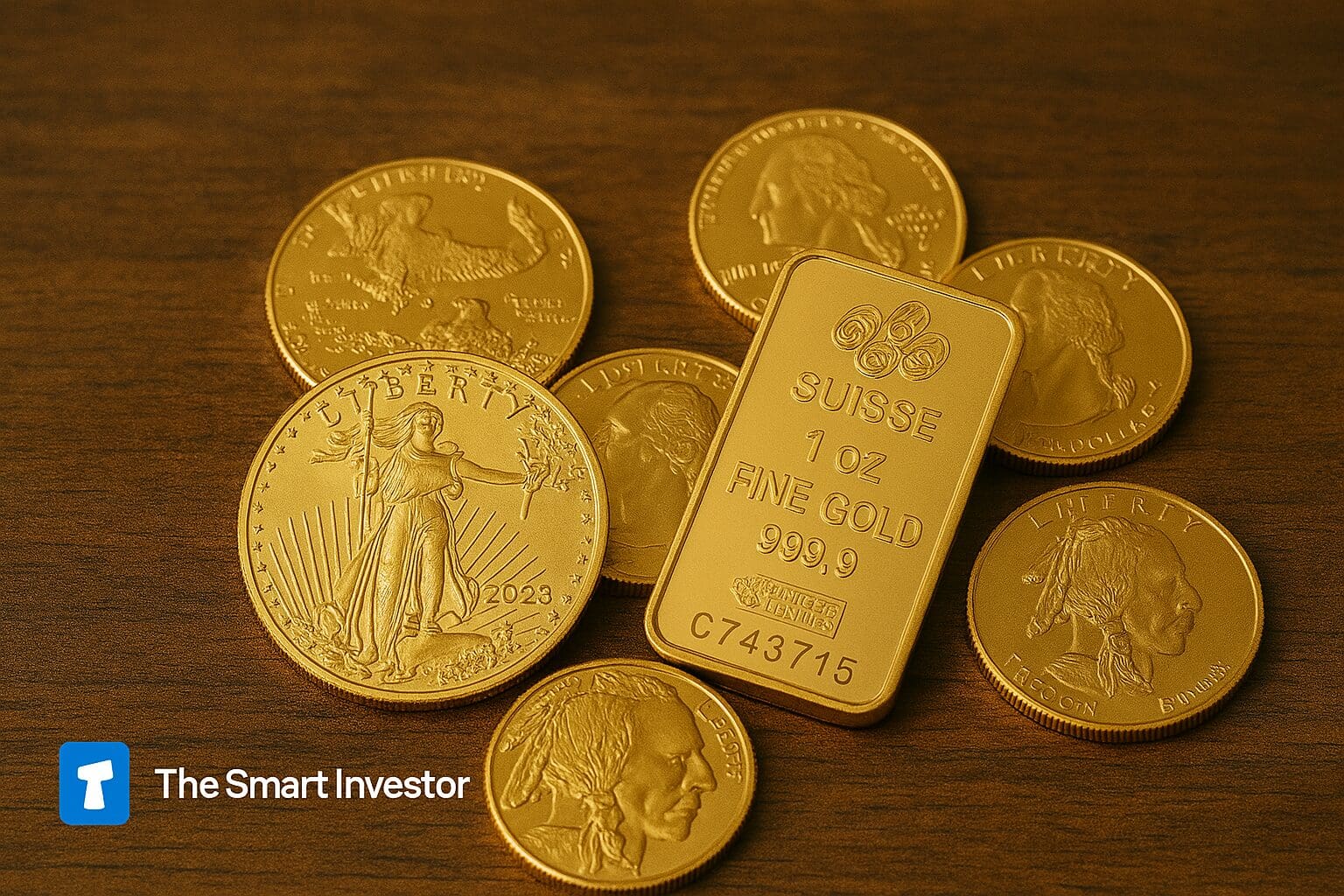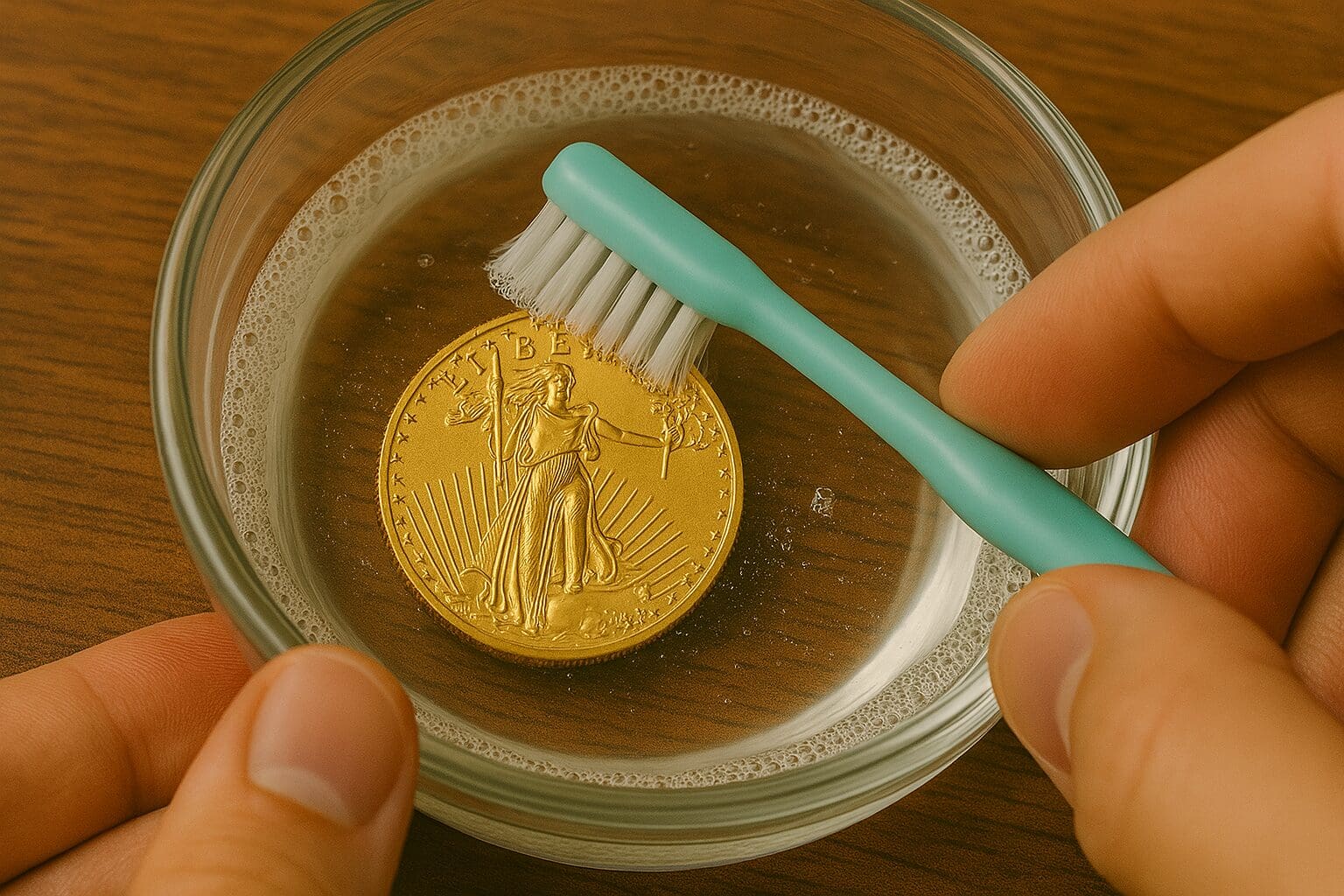Table Of Content
You’ve got a few gold coins, maybe from a family member or a recent investment, and they’re not looking as shiny as they used to.
Should you clean them? And if so, how do you do it without messing things up? Cleaning gold coins might seem simple, but doing it wrong can seriously hurt their value.
This guide walks you through everything you need to know to keep your coins in top shape—without risking costly mistakes.

Should You Clean Gold Coins?
Cleaning gold coins might seem like a good way to make them look shiny and new—but it’s not always the best move. In fact, cleaning can sometimes do more harm than good.
-
When It's Not a Good Idea
If your gold coin is old, rare, or collectible, you should never clean it.
These coins often have value beyond just their gold content—things like historical importance, limited mintage, or original surface finish matter a lot to collectors.
Cleaning can remove that natural finish (called patina) or cause tiny scratches, even if you’re being careful. That can lower the coin’s value, sometimes by a lot.
If you're ever unsure, it's better to leave it alone and have a coin expert look at it first.
-
When It Might Be Okay
On the other hand, if your coin is modern bullion—like a recent American Gold Eagle or Maple Leaf—and you’re not planning to sell it to collectors, gentle cleaning can be okay. For example:
It has fingerprints or smudges
There's sticky residue or dirt from handling
You're cleaning it only for personal display or to put in storage
Even then, it’s important to clean it very gently using safe methods like warm water and mild soap—no scrubbing, no chemicals, and definitely no polishing.
How to Clean Gold Coins Without Reducing Their Value
Not all coins are meant to be cleaned, but if you’re working with modern bullion or common pieces with no added collector value, it’s possible to clean them gently—if done right.
Here’s a step-by-step guide to cleaning gold coins while protecting their appearance and value.
-
1. Identify the Coin Type First
Before doing anything, make sure you know what type of coin you’re dealing with. If it’s a rare or antique coin, don’t clean it—have it professionally appraised first.
On the other hand, if it's a modern gold bullion coin, like a U.S. Gold Eagle or South African Krugerrand, and you’re only cleaning it for your personal collection, safe cleaning may be okay.
-
2. Use Warm Water and Mild Soap
Fill a small bowl with lukewarm distilled water (tap water can contain minerals that may stain).
Add a tiny drop of unscented dish soap. Place the coin in the water and let it soak for 5–10 minutes to loosen any dirt or residue.
Tip: Use only your fingers to move the coin around—no cloths or brushes at this stage.

-
3. Gently Rinse and Pat Dry
After soaking, rinse the coin under lukewarm distilled water. Avoid rubbing or wiping the coin.
Instead, gently pat it dry with a soft, lint-free cotton cloth or let it air dry on a clean surface. Be careful not to drop it or let it rub against anything abrasive.
-
4. Use a Soft Brush (Only if Necessary)
If dirt remains after the first rinse, use a very soft-bristled brush—like a baby toothbrush or artist’s paintbrush.
Dip it in the soapy water and lightly move it over the surface in one direction. Never scrub in circles or press too hard, as this can create fine scratches that reduce the coin’s value.
-
5. Store It Properly to Prevent Future Tarnish
Once your coin is clean and dry, place it in a non-PVC coin holder or an acid-free flip to keep it safe.
Avoid touching it with bare hands—use cotton gloves when handling coins to prevent oils and fingerprints from building up.
Proper storage means you won’t need to clean your coins as often, preserving their condition long-term.
-
Important
Always test any cleaning method on a less valuable coin first to see how it reacts. If you're unsure about cleaning, it's best to consult a coin expert or professional dealer.
Gold Coin Cleaning Mistakes to Avoid
Cleaning gold coins might seem simple, but it’s easy to make costly mistakes—especially if you’re trying to improve how a coin looks before selling it. Here are some common pitfalls to avoid:
Scrubbing with a brush or cloth: This can leave hairline scratches that permanently damage the coin’s surface.
Using harsh chemicals or jewelry cleaners: These may react with the metal or remove natural toning, reducing both appearance and value.
Cleaning collectible or numismatic coins: Even gentle cleaning can lower their worth. Never clean rare coins without expert advice.
Soaking in tap water: Minerals and chlorine in tap water can leave marks or cause long-term damage.
Drying by rubbing the coin:Rubbing to dry the coin can cause micro-abrasions. Always pat dry or air dry instead.
Skipping gloves:Touching coins with bare hands can transfer oils and dirt that leave fingerprints or stains over time.
Using Ultrasonic Cleaners for Gold Coins: Safe or Risky?
Ultrasonic cleaners may seem like a high-tech solution for cleaning gold coins, but they come with serious risks.
These devices use high-frequency vibrations to remove dirt, which can work well on solid gold jewelry.
However, gold coins are softer and more delicate, especially if they have fine details or are made from 22k or lower purity gold.
The vibrations can cause small surface abrasions, especially if the coin touches other objects during the cleaning process.
Unless you're working with common bullion and accept the risk, it’s better to use safer, manual methods.
How to Store Gold Coins to Avoid the Need for Cleaning
The best way to avoid cleaning your gold coins is to store them properly from the start. When stored right, gold coins can stay clean and untarnished for years without needing any extra care.
Here are simple storage tips to protect your coins:
Use non-PVC holders or acid-free coin flips that won’t release harmful chemicals over time.
Avoid touching coins with bare hands—wear cotton gloves to prevent fingerprints and skin oils.
Keep coins in a cool, dry place, away from moisture or drastic temperature changes.
Store them individually, so they don’t rub or scratch against one another.
Use silica gel packs in storage boxes to control humidity and prevent spotting.
Proper storage protects your investment, keeps your coins looking great, and makes cleaning rarely (if ever) necessary.
FAQ
No—it's too abrasive. Toothpaste can scratch the surface and permanently damage your coin’s finish, even with light pressure.
Pure gold doesn’t tarnish, but alloys in the coin (like copper or silver) can react with air or moisture, causing discoloration.
Avoid it. Vinegar is acidic and can damage metal surfaces or leave unwanted chemical reactions that affect the coin’s appearance and value.
Most professionals avoid cleaning unless absolutely necessary, and they use controlled, non-abrasive methods under expert supervision to protect value.
Yes—skin oils can cause discoloration or staining over time. It's better to handle coins with gloves or by the edges.
Gold won’t rust, but moisture can still leave water spots, especially on lower-karat or alloyed coins. Dry coins fully after exposure.
Polishing can cause micro-scratches and remove the natural luster. Even soft cloths can dull the surface over time.
No—cleaning can lower resale value, especially for rare or collectible coins. Leave cleaning to professionals, or skip it entirely.
Most jewelry cleaners contain chemicals that are too harsh for coins. They may damage surface detail or alter the original finish.
Yes—cleaning lowers a coin’s grade if it alters the surface, luster, or patina. This can reduce its market value significantly.
Ideally, never. If stored properly, coins don’t need regular cleaning. Only clean if there’s dirt or contamination that must be removed.
